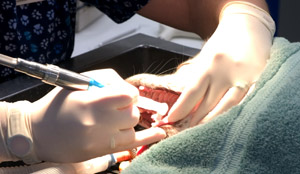Excellent Dental Care for Your Pet
A complete examination of all surfaces of the teeth is impossible to perform while the veterinary patient is awake. The external surface of some teeth may be superficially examined, but the inside surfaces of the teeth (within the oral cavity) cannot be evaluated unless anesthesia or deep sedation is administered.
Laboratory blood tests along with an ECG and radiographs are often necessary before a dental patient can be anesthetized. The older the patient, the more tests that may be needed prior to administering general anesthesia. Animals with congenital disease and pets suffering from chronic conditions are a greater anesthetic risk than completely healthy pets. If your pet is considered an anesthetic risk, your veterinarian will recommend the tests that are necessary prior to administering anesthesia.
The anesthesia given to one pet may be completely different than the anesthesia given to another pet. Your veterinarian can choose from a variety of pre-anesthetic medications and anesthesia induction agents. After the pre-anesthesia medication and induction agents are administered, general anesthesia is usually maintained with a gas agent (isoflurane or sevoflurane) mixed with oxygen. Monitoring the anesthetized patient is a fundamental procedure in veterinary medicine.

One or more of the following monitors may be used:
• Electronic Respiratory Monitor
• Pulse Oximeter
• Blood-Pressure Monitor
• Electrocardiograph (ECG)
• Esophageal Stethoscope
• Carbon Dioxide Monitor
Along with patient monitoring, it is important to keep the pet warm and comfortable during the dental procedure. Since many procedures may last longer than an hour, the pet’s core body temperature may become lowered. By using blankets, hot water bottles and heated tables, the veterinary patient’s body temperature can be maintained at its normal value.
Anesthesia or deep sedation is necessary for oral examination and dental cleaning because:
• Dental tartar is firmly attached to the surface of teeth and needs to be removed.
• Scaling by ultrasonic scalers and sharp hand instruments are necessary in order to remove the dental tartar.
• Any sudden movement can cause injury to the animal or individual performing the dental procedure.
• Dental scaling is performed above and below the gum line. Scaling the teeth above the gum line usually does not cause discomfort, however, scaling below the gum line (can cause discomfort. The area below the gum line, or subgingival space, is the most important area to clean as periodontal disease begins here.
• Humans cooperate during dental procedures, however without anesthesia or deep sedation, dogs and cats do not.
• Scaling above the gum line offers nothing but cosmetic results. Scaling must be done below the gum line.
During the last few years, veterinary dentistry has made tremendous strides. By taking advantage of the dental procedures offered at your veterinary hospital, your pet can enjoy the benefits of having excellent teeth well into his or her senior years.